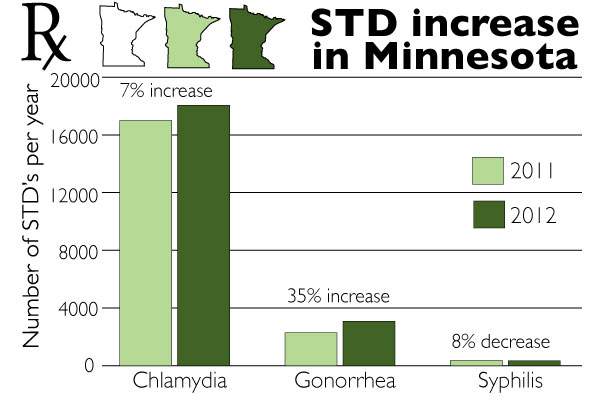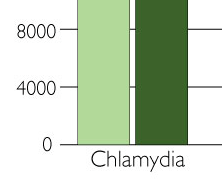
The Minnesota Department of Health reported on April 11 that the state saw a 10 percent increase of sexually transmitted diseases in 2012, but St. Thomas Health Services doesn’t provide condoms for protection.
The decision to not offer condoms to students is within the mission of the Catholic Church. Nurse Practitioner Gail Conzemius of St. Thomas Health Services said condoms are easily accessible at health care centers in the Twin Cities.
“A consistent use of a condom is the one way you can best protect yourself if you choose to be a sexually active (person),” Conzemius said. “St. Thomas is under the umbrella of the Catholic Church, so we are following what the Catholic Church advises, which is abstinence until marriage.”
In 2012, the Department of Health reported 21,465 STD cases, compared to 19,547 in 2011.
The report found chlamydia to be the No. 1-reported STD in Minnesota in 2012, reaching a new record of 18,048 cases. Gonorrhea is the second most commonly detected STD, with 3,082 cases, according to the report.
Conzemius said people young and old need to be “very conscious” of how STDs are transmitted, how the risks affects people and how to prevent contracting one.
“People don’t know they’re transmitting it. If somebody says, ‘Don’t worry I have no symptoms, I’m fine,’ they may not know,” Conzemius said. “I think that the more educated (and) the more people know about the risks, and what they should do about it, will hopefully decrease the issue.”
Junior Carissa Van Slooten found the numbers shocking and said she thinks they would have stayed the same or decreased.
“It seems like there’s been more of a push to educate kids about how to prevent this,” Van Slooten said.
Health Services educates students on STD prevention, and according to Conzemius, the best way not to catch anything is to not do anything. She said abstinence is a very important piece in preventing STDs.
Sophomore David Trout said condoms and other methods are known to not work 100 percent of the time.
“Abstinence is 100 percent effective in preventing STDs and unwanted pregnancies,” Trout said. “I believe that the importance of saving sex for marriage is one of the components of a happier and more fulfilling life.”
Junior Bryan Lee said the increase of STD cases is an accurate depiction of the times.
“More and more young people are willing to engage in sex without considering the consequences,” Lee said. “People these days can’t control their ‘urges.’”
Lee said she doesn’t think abstinence is practiced by most people and the Catholic Church isn’t stopping sex by not issuing protection.
“I think the Catholic Church needs to realize what decade it is,” Lee said. “It is foolish to think kids these days aren’t having sex, and if they aren’t going to protect themselves, someone’s got to.”
If a concerned student comes to Health Services, they will be tested with an STD-screen, which is then sent to a formal lab. The Centers for Disease Control and Prevention set the precedent of infectious disease management and Health Services follows those guidelines. Students are usually given a prescription.
Conzemius said people need to be thoughtful when they are with someone, and should not let peer pressure influence their decision-making process.
“If you look at how alcohol tends to influence people’s choices, you let down your guard. If you were sober, you wouldn’t be making that choice,” Conzemius said. “A lot of it is deciding what you’re going to do as an individual and knowing what your risks are. Knowledge is power.”
Van Slooten said abstinence and wise decision-making is important, but not providing condoms or other forms of protection doesn’t solve the problem.
“Not having anything available, while it keeps with the mission, almost feels like anything beyond the mission is being swept under the rug,” Van Slooten said.
Bjorn Saterbak can be reached at sate3878@stthomas.edu.

